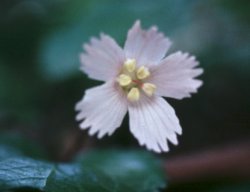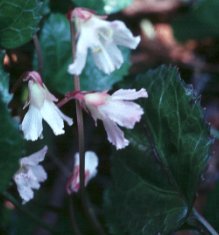|
Copies of the 48-page symposium book with contributions from all conference presenters and the bonus of three important earlier papers on Shortia galacifolia may be ordered directly from Fevertree Press, 189 Hidden Hills Ln., Athens, GA 30605
An Oconee Bell Celebration began on Friday evening with Patrick McMillan's multimedia keynote address, a provocative and thoughtful examination of André Michaux's 1787 journey to the southern mountains. Dr. McMillan is not only an accomplished field botanist and the Curator of the Clemson University Herbarium, but also host of SC ETV's award-winning natural history series Expeditions with Patrick McMillan. The exhibit of botanical art on display just outside the auditorium where Dr. McMillan made his presentation came from the Special Collections of Clemson University. Curated by Susan Hiott, the exhibit featured early 19th century color illustrations of several Michaux discoveries from the London-based Curtis's Botanical Magazine. Tim Drake led off the Saturday morning presentations in the auditorium of the Madren Conference Center. An entomologist by training, Dr. Drake is a historian by avocation especially active in historical building restorations and re-enactments. As a descendant of SC's Middleton and Pickens families, who were among André Michaux's American friends, Dr. Drake brought a personal perspective to his description of the Carolina frontier that Michaux visited in 1787 and 1788. Moreover he displayed some family heirlooms, several examples of fine hand painted chinaware from Andrew Pickens' household. The presentations continued with Brad Sanders, the author and illustrator of The Travels of William Bartram, providing a careful delineation of the routes taken by William Bartram and André Michaux as they explored this area and pointing out where each botanist made note of an important new species. AMIS Chairman Charlie Williams followed with the romantic story of André Michaux, Asa Gray, C.S. Sargent and the nineteenth century quest for and rediscovery of the "Lost Shortia". He then brought the audience up to date on the latest chapter in this engaging story. In 2004, in the herbarium of one of André Michaux's colleagues in France, a previously overlooked Michaux-collected specimen of Shortia was found and properly identified for the first time. The specimen whose label verified it had been collected by Michaux in the Carolina mountains in 1787, confirmed the accuracy of the Shortia studies published in Castanea by P. A. Davies (1956) and Robert Zahner and Steven Jones (1983). The assembly then separated into two smaller groups for the concurrent sessions. Attendees chose between presentations on native plant gardening and the latest scientific research on Shortia. Dr. Lisa Wagner, Education Director of the SC Botanical Garden and noted authority on gardening with native plants made a presentation on gardening with plants discovered by Michaux and other favorite natives for the garden. Those who chose the latest scientific research on Shortia were treated to presentations by Katherine Weeks and Todd Linscott. As a graduate student working toward a Master of Science degree at Clemson, Katherine Weeks studied reproduction in Shortia populations and she presented the results of this study. Dr. Linscott is engaged in an ongoing study of the genetics of Shortia and he shared his preliminary findings. Each researcher reported on the implications of their research on the conservation of this imperiled species. After assessing some of the well-known threats to the future of the species such as past hydroelectric projects, road building, horticultural collection and current real estate development in the areas where the plant occurs, Katherine Weeks' treated the audience to an explanation of the methods and the results of her study of reproduction in Shortia. Her study underscored the importance of insect pollinators to Shortia and she suggested the need for additional research on the identity and abundance of pollinators for this species. She called attention to the importance of preserving multiple populations as a conservation management strategy. Dr. Linscott first took us on a tour of the genus Shortia worldwide with descriptions, illustrations and range maps of the five Asian species before focusing in on his study topic the North American species. He then noted that two varieties of Shortia galacifolia have been recognized. One, Shortia galacifolia var. galacifolia, is centered in Oconee and Pickens Counties in SC and adjacent Transylvania County, NC while the other Shortia galacifolia var. brevistyla, is restricted to a few sites in McDowell County, NC. The data gathered from his initial genetic studies of the SC populations revealed high levels of diversity for a species that primarily spreads vegetatively. Future work will try to discover if the variation is due to individual plants with different numbers of chromosomes existing within the same population and determine if the two varieties are genetically distinct. The group then made the bus trip to Devil's Fork State Park where ancient populations of Shortia were in bloom along the Oconee Bell Trail and in other areas of the park. After stopping for lunch at the picnic area overlooking Lake Keowee adjacent to Duke Energy's "World of Energy" facility and orienting themselves with the three-dimensional topographic model of the mountains and lakes in the area, the group continued on to the park.
Everyone who chose to come on the field trip saw this legendary flower in bloom in its native habitat and heard interpretative remarks from our guides. They reminded us that Shortia in bloom had eluded Michaux, who discovered the plant, Asa Gray who named it, and Charles W. Short, for whom it was named. We were able to enjoy hundreds of Shortia flowers in full bloom in the plant's native habitat, while not one of these legendary figures in the history of the plant had seen this spectacle. We returned to Clemson's Madren Conference Center where Clemson Catering prepared and served a veritable feast. To complete the day, Charlie Williams appeared in costume after dinner and presented his one-man play "Andre Michaux Live.
We wish to thank the following individuals and institutions who contributed to the success of An Oconee Bell Celebration :
| ||||



